|
|
|
Sort Order |
|
|
|
Items / Page
|
|
|
|
|
|
|
| Srl | Item |
| 1 |
ID:
143423
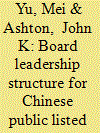

|
|
|
|
|
| Summary/Abstract |
It is widely accepted that board leadership structure and whether the chairperson and CEO roles should be undertaken jointly or separately affects the performance of a firm. Despite this consensus, empirical evidence presents major uncertainties as to the direction and degree of this influence. This study contributes to this debate by examining the relationship between board leadership structure and firm performance and the expense ratio, using propensity-score matching methods for Chinese PLCs from 2003–2010. It is reported that whilst CEO duality is not related to companies' profitability ratios, it is linked to a higher expense ratio compared to matched companies with a separate board leadership structure. This indicates that a separate board leadership structure is an effective corporate governance arrangement to reduce agency costs for Chinese PLCs.
|
|
|
|
|
|
|
|
|
|
|
|
|
|
|
|
| 2 |
ID:
143409


|
|
|
|
|
| Summary/Abstract |
This paper is devoted to examine the effect of globalization, particularly the international technology diffusion (ITD), on China's domestic carbon savings. Building on a multi-region global modeling framework, we explicitly consider both indigenous R&D and foreign technology diffusion as the dual drivers of endogenous technical change (ETC) for domestic carbon savings. Simulation results show that 1) traditional economic globalization policies like trade and FDI liberalization can boost the growth of production output, but this is at the cost of more fossil energy uses and carbon emissions; 2) technology globalization policies like removals of technology transfer barriers can facilitate the inflows of foreign technologies for domestic carbon savings; and 3) domestic emission control policies have an effect to induce restructuring and reorganization of production technology into a knowledge-intensive one and thus help lower climate compliance costs. Consequently, to create China's domestic carbon savings from globalization, policy should focus on promoting cross-country technology diffusion, beyond traditional cross-border transactions of product and capital goods. Domestic emission-based climate regulation should also be implemented to create market demand for carbon-efficient technologies and thus induce inflows of foreign advanced technologies.
|
|
|
|
|
|
|
|
|
|
|
|
|
|
|
|
| 3 |
ID:
143424
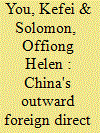

|
|
|
|
|
| Summary/Abstract |
In the past decade, China's outward foreign direct investment (FDI) has increased significantly. On the other hand, the Chinese economic growth model is heavily reliant on domestic investment. Our study examines the important issue of how China's domestic investment responds to its FDI outflows. We investigate this issue analyzing, for the first time, China's domestic investment at industrial level. We specifically account for the factor of government support given the significant role played by the state in the Chinese economy. Using industrial level data, we further evaluate whether domestic investment reacts to outward FDI differently between state dominated and non-state dominated industries. Our study adopts an accelerator model where the system-Generalized Method of Moments (GMM) is employed for our estimations. Our empirical results suggest that domestic investment responds positively to outward FDI in China, Furthermore, the FDI outflows influences domestic investment differently depending on the level of government support in the particular industries. Such influence is much stronger in state dominated industries than in the non-state dominated ones.
|
|
|
|
|
|
|
|
|
|
|
|
|
|
|
|
| 4 |
ID:
143406


|
|
|
|
|
| Summary/Abstract |
Based on Chinese city-level data from 1999 to 2012 and controlling for geological, environmental, and social diversity, our multi-step estimation suggests that credit plays a significant role in driving up house prices after the Great Recession, whereas property prices only influence bank lending before 2008. Local amenities such as higher education, green infrastructure, healthcare, and climate also positively affect house prices. Moreover, the impacts of bank loans on housing prices tend to be related to the level of amenities, suggesting that pooling macroeconomic and urban economic data may be important for housing market research in the future.
|
|
|
|
|
|
|
|
|
|
|
|
|
|
|
|
| 5 |
ID:
143412
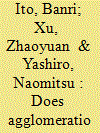

|
|
|
|
|
| Summary/Abstract |
Knowledge spillover from the agglomeration of exporters can reduce the initial costs of exporting faced by other firms and thereby facilitate exports. We use a large dataset of Chinese manufacturing firms to assess whether industrial agglomeration lowers the minimum productivity level required for exporting and whether it increases a firm's probability of exporting. Semi-parametric quantile regressions reveal that the productivity advantage of exporters against non-exporters is markedly smaller in agglomerated regions. Furthermore, a parametric estimation of an export entry model indicates that the agglomeration of incumbent exporters contributes significantly to export participation, although its magnitude is limited. These spillover effects are generated not only by the agglomeration of exporting foreign invested firms (FIFs), but also, more importantly, by that of indigenous Chinese exporters. In fact, the agglomeration of exporting FIFs only contributes to the export entry of FIFs.
|
|
|
|
|
|
|
|
|
|
|
|
|
|
|
|
| 6 |
ID:
143420


|
|
|
|
|
| Summary/Abstract |
This paper examines whether the introduction of Chinese stock index futures had an impact on the volatility of the underlying spot market. To this end, we estimate several Generalized Auto-regressive Conditional Heteroscedasticity (GARCH) models and compare our findings for mainland China with Chinese index futures traded in Singapore and Hong Kong. Our results indicate that Chinese index futures decrease spot market volatility in all three spot markets considered. In contrast, we do not obtain the same results for the companion index futures markets in Hong Kong and Singapore. China's stock market is relatively young and largely dominated by private retail investors. Nevertheless, our evidence is favorable to the stabilization hypothesis usually confirmed in mature markets.
|
|
|
|
|
|
|
|
|
|
|
|
|
|
|
|
| 7 |
ID:
143422


|
|
|
|
|
| Summary/Abstract |
In this paper, we use a unique input–output table that distinguishes trade mode and firm ownership to discuss the relative advantage of foreign-invested enterprises (FIEs) in Mainland China. It is found that FIEs outperform Chinese owned enterprises (COEs) in terms of total energy intensity by 16.97%, 14.97% and 42.89%, respectively, for the processing, non-processing and overall production in the industrial sector. Further decompositions show that structural differences across industries (and trade mode) contribute positively and account for 65.33%, 26.28% and 81.93% of the relative advantage of FIEs for processing, non-processing and overall production. Failure to capture heterogeneity across trade mode may lead to distortion of the picture of how final demand structure differences influence the energy efficiency advantage of FIEs over COEs in China.
|
|
|
|
|
|
|
|
|
|
|
|
|
|
|
|
| 8 |
ID:
143405


|
|
|
|
|
| Summary/Abstract |
Since the end of the 20th century, numerous studies have analyzed Chinese economic development to gauge whether China's rapid growth is sustainable. Most of these studies focused on assessing total factor productivity (TFP) in Chinese mainland provinces but suffered from methodological weaknesses by assuming constant returns to scale (CRS) for the production frontier and/or incorrectly modeling variables returns to scale (VRS) technology taking into account bad output such as carbon dioxide emissions. Our paper offers a right non-parametric programming framework based on weak disposability and VRS assumptions to estimate environmental growth convergence among Chinese regions characterized by size heterogeneity. We explicitly separate regional efficiency gaps into two components: The first studies the technical catching-up process on each one (technical effect), and the second reveals convergence or divergence in the combinations of input and output among regions (structural effect). Moreover, carbon shadow price levels for provinces can be derived through the dual version of our activity analysis framework. Our empirical work focuses on 30 Chinese regions from 1997 to 2010. The results emphasize that environmental growth convergence among regions has mainly relied on the structural effect. We find that the structural effect largely depends on the pollution cost convergence and not on the evolution of the relative prices of capital or labor. The carbon shadow price is increasing at an annual rate of 2.5% and was evaluated around 864 yuan per ton in 2010 in China while regional estimates show significant disparities at the beginning of the period.
|
|
|
|
|
|
|
|
|
|
|
|
|
|
|
|
| 9 |
ID:
143426


|
|
|
|
|
| Summary/Abstract |
China's ODI in Latin America and the Caribbean is entering into the second phase with diversification of economic actors and industries of investment. This paper extracts the approved projects by the Chinese Ministry of Commerce from its online database between 2003–2012, and fits a random effect negative binomial regression model. Our statistical estimates on the one hand confirm some of the previous findings on the disparity between Chinese public and private investors in their ODI motivations and perception of risks, on the other hand find that host country institutions are not purely ownership specific, but also contingent on industries and activities in which firms tend to invest. The direction of institutional effect is not consistent across sectors and firm types. The revealed complexity of China's ODI in Latin America and the Caribbean suggests a multi-level framework in further research, which treats Chinese transnational firms as endogenously heterogeneous beyond the dichotomous categorisation according to corporate ownership.
|
|
|
|
|
|
|
|
|
|
|
|
|
|
|
|
| 10 |
ID:
143418


|
|
|
|
|
| Summary/Abstract |
This paper aims to evaluate the impact of 1998 Chinese health care reform on out-of-pocket expenditure and on saving. Existing evidence on the results achieved by this reform in terms of reduction of out-of-pocket medical expenditures is still mixed and contradictory, and very little is known about the impact of these measures on the consumption and saving behavior of the Chinese population. To shed more light on this issue we use data collected in 1995 and 2002 by the Chinese Household Income Project (CHIP). Contrary to previous evidence, our findings suggest that the effects of the reform have been more articulated and heterogeneous. In fact, we find that once properly accounting for income distribution and unobserved heterogeneity (potentially induced by health status), out-of-pocket medical expenses and saving rate are affected by the reform in a differentiated way. In particular, we find that out-of-pocket expenses decrease only for high income individuals with good health status and the saving rate increases only for low income individuals with good health status. This result is actually worrisome, as it suggests that the public health coverage after the reform provides financial protection only to individuals that are relatively better off (with good health status and/or high income).
|
|
|
|
|
|
|
|
|
|
|
|
|
|
|
|
| 11 |
ID:
143410


|
|
|
|
|
| Summary/Abstract |
Industry structures and the availability and utilization of internal corporate resources are two key determinants of profit persistence. The theories behind industrial organization and the resource-based view of the firm offer different conclusions on which determinant matters most. Based on a large sample of Chinese machinery manufacturing companies listed on the Shanghai and Shenzhen A-share market between 2001 and 2010, the present study analyzes and compares the relative degrees of importance of industry and firm effects on profit persistence. The results indicate that firm effects persist longer than industry effects, therefore supporting the hypotheses of the resource-based view. Studies in this field have used different research subjects, research backgrounds, study periods and criteria for profit partition, factors which contribute to the differences in research results.
|
|
|
|
|
|
|
|
|
|
|
|
|
|
|
|
| 12 |
ID:
143417
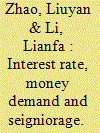

|
|
|
|
|
| Summary/Abstract |
The lack of an observable variable measuring inflationary expectation has been a major difficulty in empirical work on hyperinflation. In this paper we propose a direct measure of expectations—the black-market interest rate in Shanghai—and study the behavior of money demand in the Chinese hyperinflation. Although the log–log schedule may provide an accurate description of money demand with relatively low interest rate, the pattern of seigniorage collected in the highest hyperinflation is consistent with the prediction of the semi-log schedule. The comparison of the seigniorage actually collected with the maximum steady state level shows that the economy might be on the increasing side of the Laffer curve except for the concluding stage of the hyperinflation. This suggests that the Chinese hyperinflation has been driven mainly by the government's quest for revenue.
|
|
|
|
|
|
|
|
|
|
|
|
|
|
|
|
| 13 |
ID:
143411


|
|
|
|
|
| Summary/Abstract |
This paper examines the effects of market potential on Chinese firms' exports and profit by using data from the Chinese industrial enterprise database and The China City Statistical Yearbooks during 1998–2007. We find that international market potential has positive effects on firm exports, but negative effects on firm profit, while domestic market potential has opposite impacts. This finding suggests that Chinese firms' profit mainly stems from the domestic market. Moreover, the adverse impact of international market potential on firm profit diminishes with the increase of firm productivity, and some firms with higher productivity may benefit from the expansion of foreign markets.
|
|
|
|
|
|
|
|
|
|
|
|
|
|
|
|
| 14 |
ID:
143429


|
|
|
|
|
| Summary/Abstract |
This paper investigates the time-varying impact of oil price uncertainty on stock prices in China using weekly data on ten sectoral indices over the period January 1997–February 2014. The estimation of a bivariate VAR-GARCH-in-mean model suggests that oil price volatility affects stock returns positively during periods characterised by demand-side shocks in all cases except the Consumer Services, Financials, and Oil and Gas sectors. The latter two sectors are found to exhibit a negative response to oil price uncertainty during periods with supply-side shocks instead. By contrast, the impact of oil price uncertainty appears to be insignificant during periods with precautionary demand shocks.
|
|
|
|
|
|
|
|
|
|
|
|
|
|
|
|
| 15 |
ID:
143414
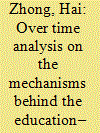

|
|
|
|
|
| Summary/Abstract |
In this paper, we examine the over time changes in the relationship between education and health in the past two decades in China. We do not find a clear education–health gradient in the early 1990s. However, the education–health gradient emerges and steadily grows. We test a number of different theories that may explain the observed trend. We show that the mechanisms behind the education–health gradient in developing countries might be different from those in developed countries, and heterogeneous across health measures, both of which may have some important policy implications.
|
|
|
|
|
|
|
|
|
|
|
|
|
|
|
|
| 16 |
ID:
143413


|
|
|
|
|
| Summary/Abstract |
This paper evaluates the performance of national HTZs in China after the financial crisis. Unlike previous case studies or comparative analyses, we employ the Dynamic Network Slack-based Measurement to open the “black box” and examine the HTZs as a network that is connected by carry-overs between sequenced terms and links among different sectors. The results show that: 1) the efficiencies of both production sectors and R&D sectors are low in most Hi-tech zones, partly because the links between them are weak and the carry-overs are inappropriate; and 2) Total Factor Productivity exhibits that production sectors mainly depend on technical efficiency improvement, while R&D sectors hinge on technology progress.
|
|
|
|
|
|
|
|
|
|
|
|
|
|
|
|
| 17 |
ID:
143427


|
|
|
|
|
| Summary/Abstract |
This study investigates the relationship between the real exchange rate (RER) and economic growth in China applying a cointegrated VAR (CVAR) model. However, in contrast to the assumptions of trade partners, this paper finds that the Chinese economy has not benefited from the lower exchange rate of the RMB, and no direct linkages exist between the RER and growth in the long run. Interestingly, it appears that the Chinese economy is stimulated by the expansion of exports and inflow of foreign capital according to the empirical evidence, which also suggests that the long run equilibrium RER is jointly determined by the foreign trade, foreign reserves and the foreign direct investment. In addition, the 2005 RMB policy reform did not show any significant impact on the RER, but instead contributed to the steady economic growth. It is clear that, after the 2008 world crisis, the RMB exchange rates were largely dependent on the enhancing of the national strength and inflow of foreign capital, rather than the slow increase in foreign trade. As for policy implications, China may insist on the managed floating exchange rate policy making limited adjustments to the currency's daily floating range in response to the pressures from trade partners.
|
|
|
|
|
|
|
|
|
|
|
|
|
|
|
|
| 18 |
ID:
143408


|
|
|
|
|
| Summary/Abstract |
Our study documents the recent narrowing of the coast-inland divide in China. We argue that this rebalancing reflects, with a time lag, the catching up process which has been at work in the industry of the inland region since the end of the 1990s. The pattern is in line with the rapid and unconditional convergence observed in China's manufacturing industry over this period. The convergence of labor productivity suggests that advanced coastal regions have transferred capital and technology to the interior.
|
|
|
|
|
|
|
|
|
|
|
|
|
|
|
|
| 19 |
ID:
143425


|
|
|
|
|
| Summary/Abstract |
Using annual data for the periods 1992–2012, this paper examines trade flows between China and its main trade partners in Asia, North America and Europe, and whether increasing trade has led to industrial structural adjustment and changes in China's trade patterns. The analysis is based on both economic indicators and the estimation of a gravity model, and applies recently developed panel data methods that explicitly take into account unobserved heterogeneity, specifically the fixed effect vector decomposition (FEVD) technique. The findings confirm the significant change in China's trading structure associated with the fast growth of foreign trade. In particular, there has been a shift from resource- and labour-intensive to capital- and technology-intensive exports.
|
|
|
|
|
|
|
|
|
|
|
|
|
|
|
|
| 20 |
ID:
143419


|
|
|
|
|
| Summary/Abstract |
We use data from the World Bank Global Findex database for 2011 to analyze financial inclusion in China, including comparisons with the other BRICS countries. We find a high level of financial inclusion in China manifested by greater use of formal account and formal savings than in the other BRICS. Financial exclusion, i.e., not having a formal account, is mainly voluntary. The use of formal credit is however less frequent in China than in the other BRICS. Borrowing through family or friends is the most common way of obtaining credit in all the BRICS countries, but other channels for borrowing are not very commonly used by individuals in China. We find that higher income, better education, being a man, and being older are associated with greater use of formal accounts and formal credit in China. Income and education influence the use of alternative sources of borrowing. Overall financial inclusion does not constitute a major problem in China, but such limited use of formal credit can create a challenge for further economic development.
|
|
|
|
|
|
|
|
|
|
|
|
|
|
|
|
|
|
|
|
|